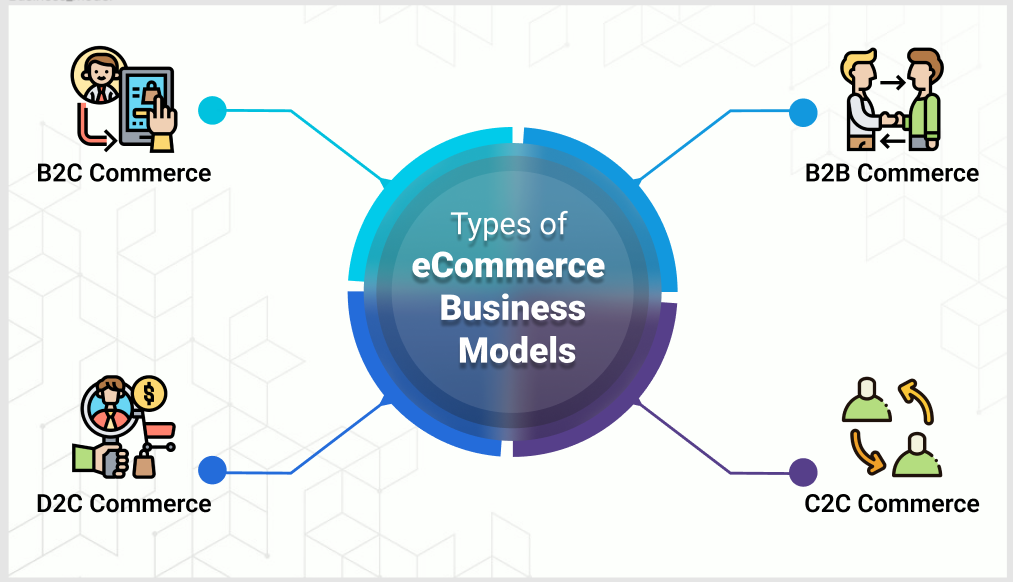How Ecommerce and Operating Models Are Connected !

Both B2C and B2B companies have seen some rising trends that have impacted their business to a great extent. One of the primary causes of these changes is the COVID-19 pandemic which disrupted the workflow of businesses worldwide.
Consequently, businesses witnessed fundamental changes in consumer behaviour, supply chains, and overall operations.
Both small and large businesses that managed to make it through the pandemic by adopting digital transformation and new ways of working to adjust to the new normal. While businesses are still rewriting the path to recovery, the operating model is one of the most pressing changes that require immediate attention. Having a suitable operating model is the key to sailing through these changes.
COVID–19 Giving Rise to E-Commerce
The pandemic was hard on the overall economy, but during this period shopping habits of consumers led to a surge in e-commerce. This boosted digital transformation.
In a recent report, COVID-19 and E-Commerce: A Global Review, by UNCTAD and eTrade for all partners, findings revealed a rise in e-commerce's share of global retail trade from 14% in 2019 to almost 17% in 2020.
As the pandemic continued, consumers shifted to online shopping because of the circumstances. Departmental stores and shops were temporarily closed, and even when the lockdown was partially lifted, most individuals tried to limit their time spent outside. Naturally, they turned to online shopping as a reliable source for daily essentials.
Businesses soon raced to create their digital presence. Many brick-and-mortar stores partnered with e-commerce websites to provide consumers with the luxury of shopping from home.
The driving growth behind e-commerce platforms is the provision to use discount coupons, read reviews before shopping, fast checkout, free doorstep delivery, and the ability to return items. 28% of US shoppers use mobile phones in a physical store to look up discounts, compare prices, and read product reviews.
Popular E-Commerce Models

Each e-commerce platform follows a unique business model to set its business apart. We at Growth Jockey believe that when you realise which model works best for you, you can leverage it to your business needs. If you plan to launch an e-commerce platform or take your offline business to new levels, get in touch with us so that we can turn your plans into action. Here are some of the operating models businesses can adopt:
-
B2C (Business-to-Consumer)
This model has a shorter sales cycle as it typically sells products directly to end consumers. Any product or service can be sold in this model. The business markets them directly to targeted consumers.
-
B2B (Business-to-Business)
This model is for businesses selling their products to other businesses. The buyer then sells them to the consumer. Companies usually buy products in bulk, and enterprises have fixed buyers.
-
C2C (Consumer-to-Consumer)
E-commerce platforms have given rise to this unique concept where consumers can sell previously owned or new products and services to other consumers.
-
C2B (Consumer-to-business)
C2B is a popular model which allows consumers to sell products or services directly to companies. Sometimes companies require specific services, and instead of hiring professionals, they outsource freelancers to work on these projects.
-
B2B2C (Business-to-Business-to-Consumer)
In this model, three parties are involved in the transaction of goods. Businesses usually partner with other companies to sell their products online.
-
B2G (Business-to-Government)
This model is very different and requires legal procedures as businesses can sell their service or products to government agencies, public administration, etc. Usually, the business has to go to the official website and bid on the projects to secure the deal.
Why Do E-Commerce Platforms Need the Right Operating Model?
It is common for businesses to struggle in the initial phase while trying to transition to an e-commerce platform. This is where the operating model fits in.
Every business needs an operating model to successfully carry out operations and daily tasks, run the supply chain without interruptions, and keep customers happy.
Deloitte describes an operating model as "the configuration of the organisation to deliver its strategy". In simple words, an operating model is necessary to understand all the processes the business needs to go through to deliver value.
Businesses that lack an operating model also lack strategy. A business would fall apart without a suitable operating model. They can either transform the existing operating model to fit the changes the company is undergoing or develop a new one.
Some of the primary areas of an e-commerce platform that can benefit from an operating model include:
-
Supply chain management
-
Warehouse administration
-
Receiving Inventory and management
-
Customer order picking and packing
-
Logistics of shipping
-
Customer care
For instance, let's take an example of an e-commerce business selling groceries, organic vegetables, and other daily essentials to customers. It collects all items from B2B sellers at regular intervals.
All items are stored at the warehouse, which professionals manage. They look over the process of collecting items, labelling and storing them properly, and dispatching them from the warehouse. Items often go through quality checks at the warehouse. Upon receiving customer orders, delivery persons ship the items to the exact locations. Some businesses connect with professional delivery partners who take care of shipping and delivery.
This represents how the business runs and delivers value to customers. With operating models in ecommerce, the company would know how to source their products or the strategy to organise and dispatch the products.
As an ecommerce business expands, new responsibilities emerge, such as managing a multichannel or omnichannel retail strategy, inventory distribution, and so on.
How GrowthJockey Develops the Right Operating Model for E-Commerce Platforms
No magic wand gives you the ideal operating model for your business. Companies need a proper strategy to develop an effective operating model. They should focus on three things while developing the model; process, people, and technology.
Each operating model is unique, even for an e-commerce platform that sells the same products. This is because of how they function, the number of employees, and the targeted audience vary.
Companies can take two approaches when developing the operating model for their business:
-
Role-Based
When individuals focus on the employees, their roles, and the hierarchy within the organisation, they take the role-based approach in designing the operating model.
-
Process-Based
This approach focuses on the entire process or journey within the organisation that delivers the end product to consumers. They focus on this journey from how the company sources items to delivering value to the consumers.
It is up to the company to determine which approach works for its business. A role-based system works best if you plan to restructure your company and add more people. But process-based will work better if you modify the model to manage resources.
Modify or Create an Operating Model Today
The digital economy saw a sharp rise during the pandemic, leading to different e-commerce platforms worldwide. Consumers are turning to these platforms more than ever because of their convenience.
If your business needs help to boost sales or reach the targeted consumers, it's time you shift your focus to the online space. And for a smooth transition, you need an operating model you can rely on.
GrowthJockey helps businesses identify their gaps and bridge them with advanced solutions. The key is to stay updated with recent trends, competitors, and consumer behaviour.
When businesses try to focus on everything at once, they end up without a failproof plan. With GrowthJockey, you can trust our experts to drive you on the right path. We adopt the latest technology to determine the best operating plan suitable for different businesses.
At GrowthJockey, we are fully committed to developing customised operating models that effectively address the critical challenges faced by our clients across various industries. Irrespective of your company's size, whether it's a small-scale enterprise or a large corporation, you can now benefit from our tailored solutions. Take the decisive step towards unlocking the next level of growth for your brand by reaching out to us today!








